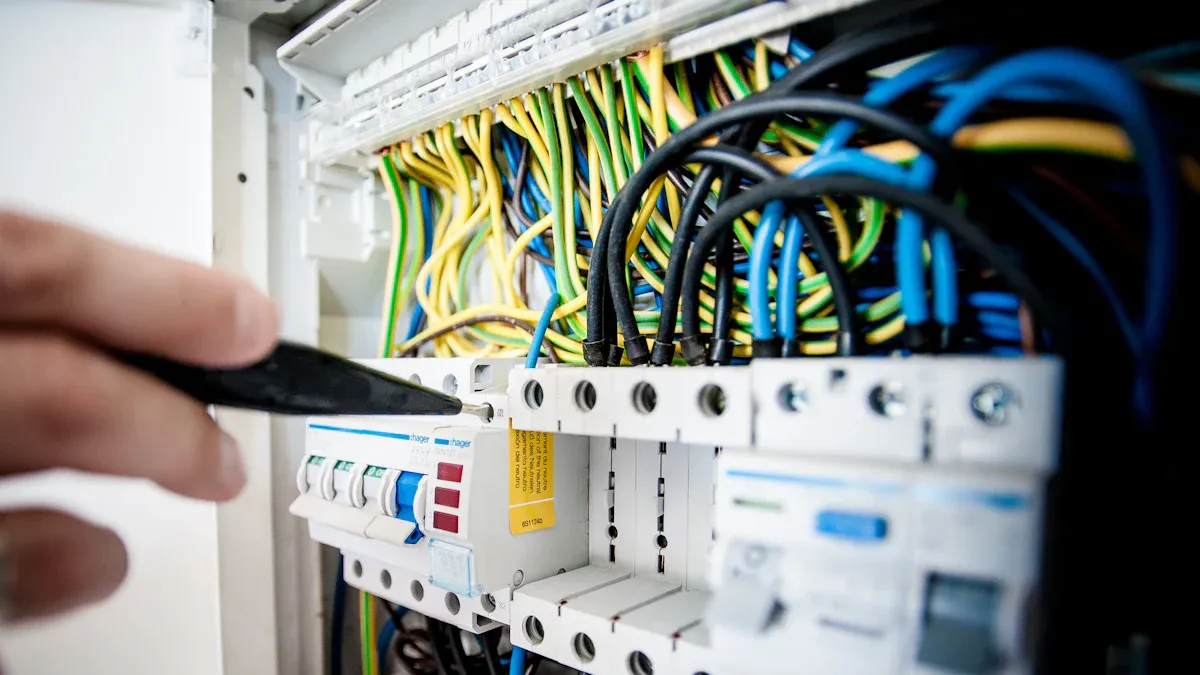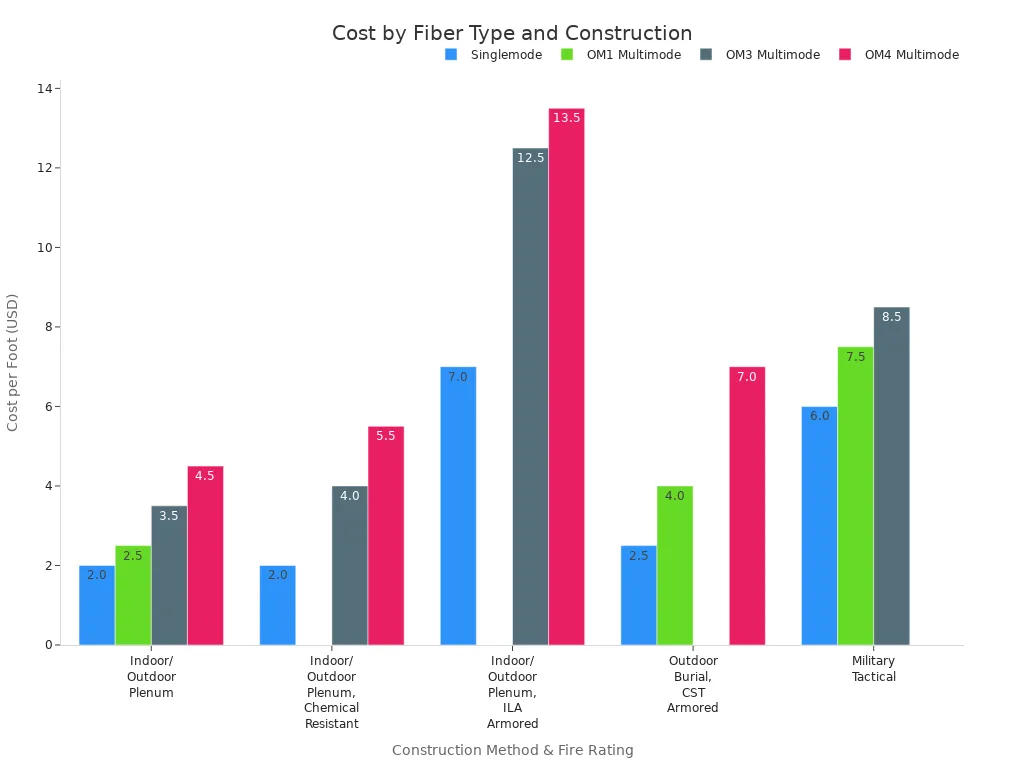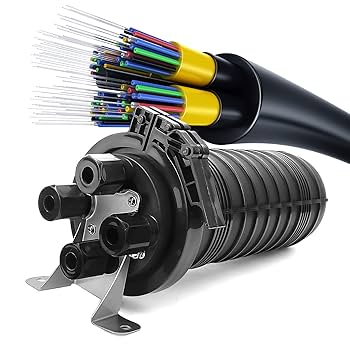Fire-Rated Fiber Optic Enclosures help commercial buildings meet strict fire safety codes. These enclosures, including Fiber Optic Splice Closure and Vertical Splice Closure, block fire from spreading through cable routes. A 3 Way Fiber Optic Enclosure or Vertical Heat-Shrink Joint Closure also protects network equipment and keeps fire barriers strong.
Key Takeaways
- Fire-rated fiber optic enclosures protect buildings by blocking fire, smoke, and heat from spreading through cable routes, helping meet strict fire safety codes.
- Choosing the right enclosure means matching fire resistance ratings, certifications, and materials to the building’s environment and code requirements.
- Proper installation, labeling, and regular maintenance ensure long-term safety, compliance, and protection of critical network infrastructure.
Fire-Rated Fiber Optic Enclosures: Definition and Role
What Are Fire-Rated Fiber Optic Enclosures
Fire-Rated Fiber Optic Enclosures serve as protective housings for fiber optic cables in commercial buildings. Manufacturers design these enclosures to withstand high temperatures and block the passage of flames, heat, and smoke. By sealing cable penetrations in fire-resistance rated walls, floors, and ceilings, these enclosures help maintain the integrity of fire-rated barriers. Specialized products, such as intumescent blocks and fire protection plugs, address irregular or hard-to-reach cable pathways. These solutions reinforce compromised drywall or concrete, keeping fire and smoke contained within designated compartments. This containment extends evacuation time and limits fire spread, which is critical for occupant safety.
Importance for Commercial Building Compliance
Commercial buildings must comply with strict fire safety codes. Fire-Rated Fiber Optic Enclosures play a vital role in meeting these requirements. Non-compliance can result in serious consequences:
- Denied insurance claims for fire-related losses
- Increased insurance premiums after inspections
- Coverage limitations or exclusions
- Potential policy cancellation for severe violations
- Fines and citations from regulatory agencies or fire marshals
- Correction orders that may restrict business operations
- Emergency repair costs that exceed planned budgets
- Reputational damage that can last beyond the repair period
Non-compliant fire doors and barriers can increase average fire damage costs by about 37% in commercial settings, according to NFPA data. Regulatory authorities may impose fines, citations, or legal actions. Insurance providers often view compliance favorably, which can reduce premiums and liability risks. Fire-Rated Fiber Optic Enclosures help building owners avoid these risks and protect both people and property.
Fire-Rated Fiber Optic Enclosures: Fire Safety Standards and Certifications
NEC Article 770 and NFPA 70 Requirements
The National Electrical Code (NEC) Article 770 and NFPA 70 set the foundation for fire safety in fiber optic installations. These codes require that Fire-Rated Fiber Optic Enclosures and cables do not increase the risk of fire or smoke spread within a building. Installers must firestop all penetrations through fire-rated walls, floors, and ceilings using approved methods. This preserves the fire resistance rating of each barrier. Cables must be installed securely, using hardware that avoids damage. In air-handling spaces, nonmetallic cable ties must have low smoke and heat release properties.
A key aspect of compliance involves selecting the correct cable type for each building environment. The NEC classifies optical fiber cables by their fire resistance and smoke characteristics. The table below summarizes which cable types are permitted in specific spaces:
| Cable Type | Plenum | Riser | General Use | Ducts/Raceways | Shafts |
|---|---|---|---|---|---|
| OFNP/OFCP | Y* | Y* | Y* | Y* | Y* |
| OFNR/OFCR | N | Y* | Y* | Y* | Y* |
| OFNG/OFCG | N | N | Y* | N | N |
| OFN/OFC | N | N | Y* | N | N |
Y indicates permitted use, subject to limitations in NEC sections 770.110 and 770.113.
Circuit integrity (CI) cables used for critical systems must meet a minimum two-hour fire rating, tested according to ANSI/UL 2196. These requirements align with additional fire test standards, such as NFPA 262 and UL 1685. Dowell provides Fire-Rated Fiber Optic Enclosures that meet these rigorous standards, supporting safe and compliant installations in commercial buildings.
UL, IEC, and ANSI Certifications
Certifications from organizations such as UL (Underwriters Laboratories), IEC (International Electrotechnical Commission), and ANSI (American National Standards Institute) validate the fire performance of fiber optic enclosures. UL certification, for example, confirms that enclosures and cables have passed standardized fire resistance and smoke emission tests. IEC standards, including IEC 60332 and IEC 61034, address flame propagation and smoke density for optical fiber cables. ANSI standards, such as ANSI/UL 2196, set benchmarks for circuit integrity during fire exposure.
Manufacturers like Dowell design and test their Fire-Rated Fiber Optic Enclosures to meet or exceed these certifications. Building owners and contractors should always verify that products carry the appropriate listings and markings. This ensures that the selected enclosures will perform as required during a fire event and satisfy inspection requirements.
Practical Meaning of Compliance
Compliance with fire safety standards and certifications delivers real-world benefits for commercial buildings. Properly installed and certified Fire-Rated Fiber Optic Enclosures help maintain the integrity of fire barriers, limit the spread of flames and smoke, and protect critical network infrastructure. Insurers often require documented compliance before issuing or renewing policies. Regulatory agencies may conduct inspections to verify that all cable penetrations and enclosures meet code requirements.
Recent changes in the NEC reflect ongoing efforts to streamline and clarify fire safety rules. The 2026 NEC update moves the content of Article 770 into new articles within the limited-energy systems section. This organizational change does not alter the core requirements for fire-rated enclosures but highlights the importance of staying current with evolving codes. Dowell remains committed to providing up-to-date solutions that help clients achieve and maintain compliance.
Tip: Regularly review code updates and product certifications to ensure ongoing compliance and avoid costly retrofits or penalties.
Fire-Rated Fiber Optic Enclosures: Materials and Construction

Fire-Resistant Materials (Plenum, PVC/Riser, LSZH)
Manufacturers select materials for fiber optic enclosures based on fire resistance and safety requirements. Plenum, PVC/riser, and LSZH (Low Smoke Zero Halogen) materials each offer distinct fire ratings. Plenum-rated cables, marked as OFNP, provide the highest flame retardancy and are essential in air handling spaces. These cables use materials like fluorinated ethylene polymer (FEP) or specialized PVC, which limit flame spread and produce minimal smoke. LSZH cables contain no halogens, so they emit very little smoke and no toxic gases during combustion. This feature makes LSZH ideal for confined or public spaces where smoke inhalation poses a significant risk. PVC/riser cables, labeled OFNR, are suitable for vertical runs between floors but have lower fire resistance and higher toxicity due to halogen content.
| Feature | PVC/Riser Cable | Plenum Cable | LSZH Cable |
|---|---|---|---|
| Flame Resistance | Average | Very Good | Good |
| Self-Extinguish | Poor | Very Good | Good |
| Halogen Content | Contains Halogens | Contains Halogens* | Halogen-Free |
| Smoke Production | Higher | Very Low | Very Low |
| Toxicity | Higher | Lower | Lowest |
*Note: Some plenum cables are halogen-free but generally contain halogens.
Construction Methods for Fire Rating
Engineers design enclosures to meet strict fire resistance standards. Tests such as UL 94 and PH120 evaluate how materials behave under fire conditions. A V-0 rating under UL 94 means the material self-extinguishes quickly and does not drip flaming particles. PH120 certification ensures the enclosure protects internal hardware for up to 120 minutes during a fire. Manufacturers use vertical and horizontal burn tests, mechanical shock, and water spray simulations to verify performance. These methods ensure that enclosures maintain their integrity and protect network components during fire exposure.
Comparison of Enclosure Options
Selecting the right enclosure involves balancing durability, fire resistance, installation ease, and cost. Plenum cables offer the highest fire rating and durability, making them suitable for air handling spaces but at a higher price. Riser cables provide moderate fire resistance and are easier to install in vertical shafts. LSZH cables excel in low smoke and toxicity, ideal for sensitive environments, though they are not direct substitutes for plenum cables. Outdoor cables, such as PE, resist weather but lack indoor fire ratings.
| Cable Type | Durability | Fire Resistance | Ease of Installation | Cost Considerations |
|---|---|---|---|---|
| Plenum | High | Highest | Requires compliance | More expensive |
| Riser | Durable | Moderate | Easier in risers | Less expensive |
| LSZH | Durable | Good | Specialized areas | More expensive |
| PE (Outdoor) | High | Not suitable | Outdoor only | Varies |

Tip: Always match enclosure materials and ratings to the building’s fire safety requirements and installation environment for optimal protection and compliance.
Fire-Rated Fiber Optic Enclosures: Selection Criteria
Building Code and Regulatory Considerations
Every commercial building must follow local, state, and national fire safety codes. Authorities such as the National Fire Protection Association (NFPA) and the International Building Code (IBC) set strict rules for cable management and fire barrier integrity. Inspectors often check if Fire-Rated Fiber Optic Enclosures meet these standards. Building owners should review the following before selecting an enclosure:
- Fire Resistance Rating: The enclosure must match or exceed the fire rating of the wall, floor, or ceiling it penetrates.
- Certification Requirements: Products should carry recognized certifications, such as UL or IEC, to ensure compliance.
- Documentation: Proper records of installation and product specifications help during inspections and insurance reviews.
Note: Local codes may have unique requirements. Always consult with a licensed fire protection engineer or code official before finalizing product selection.
Environmental and Application Factors
The environment where the enclosure will be installed plays a major role in product selection. Different spaces in a commercial building present unique challenges. For example, air handling spaces require plenum-rated materials, while riser shafts need riser-rated products. Moisture, temperature, and exposure to chemicals can also affect performance.
Key environmental and application factors include:
- Location: Indoor, outdoor, plenum, riser, or general use areas
- Temperature Range: Some enclosures must withstand extreme heat or cold
- Moisture and Corrosion Resistance: Wet or humid environments require enclosures with special seals or coatings
- Mechanical Protection: High-traffic or industrial areas may need reinforced enclosures
A table can help compare environmental needs:
| Application Area | Required Rating | Environmental Challenge | Recommended Feature |
|---|---|---|---|
| Plenum Spaces | Plenum (OFNP) | Airflow, smoke control | Low smoke, flame retardant |
| Riser Shafts | Riser (OFNR) | Vertical fire spread | Self-extinguishing |
| Outdoor Areas | UV/Weather Resistant | Sun, rain, temperature | Sealed, UV-stable |
| Industrial Zones | Impact Resistant | Vibration, dust, chemicals | Reinforced, gasketed |
Matching Features to Project Needs
Selecting the right Fire-Rated Fiber Optic Enclosures involves more than just code compliance. Project managers must balance safety, performance, and budget. The following checklist can guide the decision-making process:
- Assess the Building Layout: Identify all fire-rated barriers and cable pathways.
- Determine Required Ratings: Match enclosure ratings to the fire resistance of each barrier.
- Evaluate Cable Types: Choose enclosures compatible with plenum, riser, or LSZH cables as needed.
- Consider Future Expansion: Select enclosures with extra capacity for future cable additions.
- Review Installation Requirements: Some enclosures offer tool-less entry or modular designs for faster installation.
- Check Maintenance Needs: Easy-access panels and clear labeling simplify inspections and repairs.
Tip: Involve IT, facilities, and safety teams early in the planning process. Their input ensures the selected enclosures meet both technical and regulatory needs.
A well-chosen enclosure protects network infrastructure, supports code compliance, and reduces long-term costs. Fire-Rated Fiber Optic Enclosures provide peace of mind for building owners and occupants by combining safety with reliable performance.
Fire-Rated Fiber Optic Enclosures: Installation and Maintenance
Installation Best Practices
Proper installation ensures both safety and code compliance. Installers should follow these best practices:
- Select cables and raceways that meet NEC Article 770 requirements.
- Firestop every penetration of fire-rated walls, partitions, floors, or ceilings. Always follow manufacturer instructions and NEC 300.21.
- Restore the integrity of any fire barrier after making penetrations for fiber optic installations.
- Use plenum-rated cables and raceways in environmental air spaces, such as above suspended ceilings or below raised floors.
- Support cables with the building’s structural components and approved fittings. Avoid using ceiling grids or ceiling-support wires.
- Arrange cables neatly and in a workmanlike manner to comply with NEC 770.24. This also ensures easy access for future maintenance.
- Position above-ceiling cables so that suspended ceiling panels can be moved without obstruction, preventing code violations.
Tip: Careful planning before installation reduces the risk of costly corrections and ensures long-term reliability.
Labeling and Documentation Requirements
Accurate labeling and thorough documentation help maintain compliance and simplify future inspections. Each enclosure and cable should display clear, durable labels that indicate fire rating, installation date, and cable type. Installers should maintain detailed records, including product certifications, installation diagrams, and fire barrier restoration details. Organized documentation supports smooth inspections and insurance claims.
Inspection and Ongoing Maintenance
Routine inspections keep systems safe and compliant. Facility teams should check enclosures for physical damage, label legibility, and barrier integrity. Maintenance schedules should include periodic testing of firestopping materials and prompt repair of any deficiencies. Regular reviews ensure that all components continue to meet evolving code requirements.
Fire-Rated Fiber Optic Enclosures support compliance and protect vital infrastructure in commercial buildings. These enclosures prevent fire and toxic gas spread, offer durable protection against environmental hazards, and help reduce insurance costs. Their use enhances operational continuity and risk management for building owners.
- Protects critical components for up to four hours
- Reduces maintenance needs
- Supports installation in diverse environments
By: Eric
Tel: +86 574 27877377
Mb: +86 13857874858
E-mail: henry@cn-ftth.com
Youtube: DOWELL
Pinterest: DOWELL
Facebook: DOWELL
Linkedin: DOWELL
Post time: Jul-16-2025

